What is Comfort Layers?
Comfort layers refer to the components of a mattress designed to provide cushioning and support.
Description
In the realm of interior design, understanding the various materials and textiles that contribute to our comfort and well-being is crucial. Comfort layers are specific elements within the structure of a mattress that are engineered to offer both support and a soft, cushioning effect to the sleeper's body. These layers can be made from a variety of materials, including memory foam, latex, gel, or polyurethane foam, each providing a unique combination of comfort and support.
The arrangement and type of comfort layers are pivotal in determining the overall comfort level of the mattress. For instance, memory foam is renowned for its pressure-relieving properties, conforming closely to the body's contours. This can significantly enhance sleep quality by reducing pressure points and supporting proper spinal alignment. Meanwhile, gel-infused foams are designed to provide a cooling effect, ideal for individuals who tend to overheat during the night.
Selecting the right comfort layers involves considering personal preferences and needs, such as desired firmness, support levels, and temperature regulation. The interplay between comfort layers and other components like the support core determines the mattress's performance in terms of comfort, durability, and overall sleep experience.
Usage
Comfort layers are most commonly discussed in the context of mattress selection, especially when considering the specific needs of an individual sleeper. For example, someone with back pain might opt for a mattress with firmer support layers under softer, conforming comfort layers to ensure both adequate support and pressure relief.
FAQs
-
Which materials are commonly used for comfort layers?
Common materials for comfort layers include memory foam, latex, gel-infused foams, and polyurethane foam.
-
How do comfort layers affect sleep quality?
Comfort layers can improve sleep quality by providing cushioning, reducing pressure points, and ensuring proper spinal alignment, depending on their material and firmness.
-
Can comfort layers affect the temperature of a bed?
Yes, certain materials, like gel-infused foams, are designed to have a cooling effect, which can be beneficial for people who tend to sleep hot.
Practical Application
When choosing a mattress, consider your personal comfort preferences, any specific support needs, and whether temperature regulation is a priority for you. Testing mattresses in-store can offer tangible insight into how different comfort layers feel, but remember that the best selection will align with your unique sleep habits and health considerations.
-
Materials & Textiles360 articles
-
Textiles & Upholstery252 articles
-
Accessibility & Ergonomics30 articles
-
KilimKilim refers to a flat tapestry-woven carpet or rug traditionally produced in countries of the former Persian Empire, Eastern Europe, and the Balkans.
-
FauteuilA fauteuil is a style of open-arm chair with a primarily wooden frame.
-
CarpetCarpet is a floor covering made from thick woven fabric.
-
Biophilic DesignBiophilic Design is an approach to architecture and interior design that seeks to connect building occupants more closely to nature.
-
EscritoireAn escritoire is a writing desk, typically featuring a hinged writing surface.
